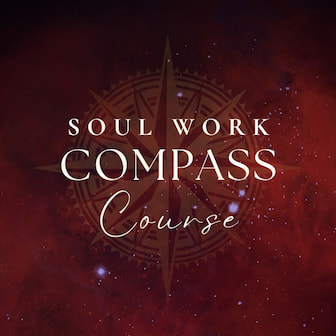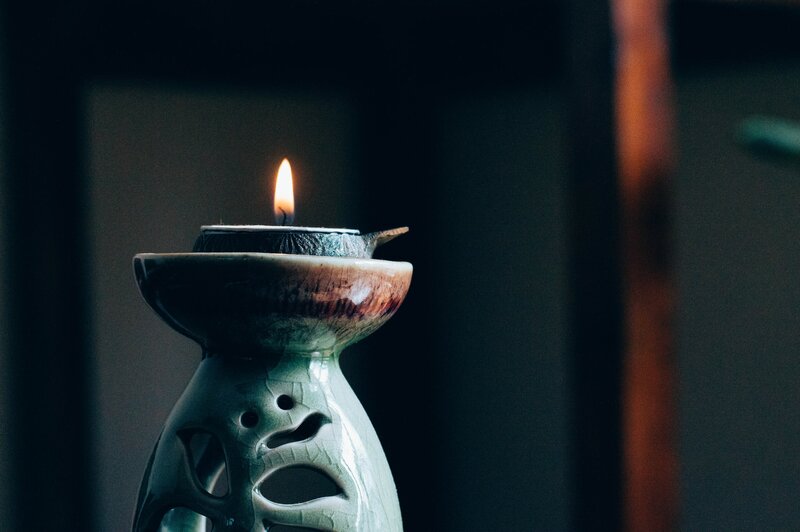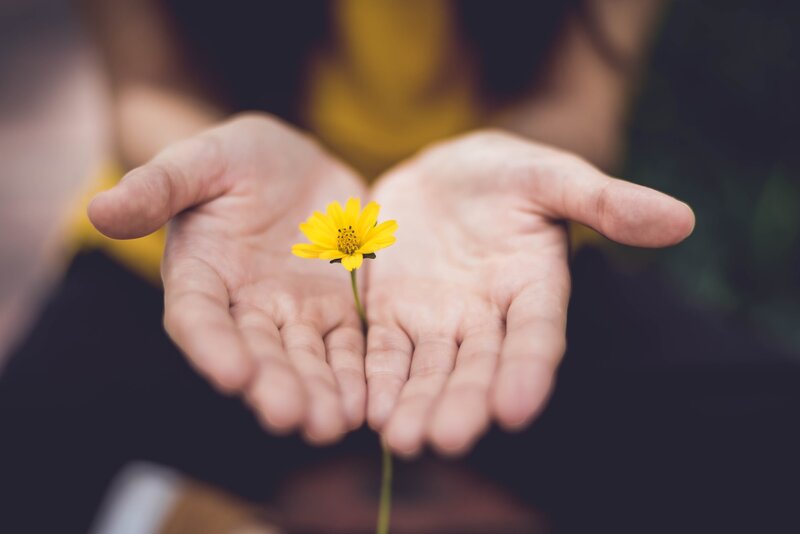Spiritual meditation is different from mainstream meditation in that it focuses on connecting with something greater and deeper than ourselves.
Normal meditation – the kind you read about in journalist columns, hear about in talk shows, and watch on the news – is a great first step in the door.
With the extensive research backing meditation, it’s no wonder that people with little to no interest in spirituality are doing it.

Soul Work Compass Course:
Feeling lost, stuck, and trapped in repetitive cycles of pain? Discover your Soul's Compass to reclaim your purpose and find your path to freedom.
⭐️⭐️⭐️⭐️⭐️ "I have been a long-time subscriber to their website, and it’s one of my favorites by far ... It is rare to find this type of teacher." – Shar B.
But if you’re a soul seeker and spiritual sojourner, you might crave to find extra meaning, depth, and value in your meditation practice.
This article can help open some doorways for you in a simple, concise way.
Table of contents
What is Spiritual Meditation?

Spiritual meditation is a way of reconnecting with Spirit – or the Divine force and Higher essence of life.
During spiritual meditation, it’s not uncommon to have experiences of:
- Mystical experience
- Ego death
- Deep insights into the nature of self/reality
- Kundalini (spiritual) energy
- Spiritual Oneness and expansion
- Inner peace
Some people even report altered states of consciousness that feel similar to out-of-body experiences.
While we don’t always have these profound experiences, they’re more likely to happen when we orient ourselves to a more spiritual form of meditation.
Types of Spiritual Meditation

One conscious breath in and out is a meditation.
– Eckhart Tolle
Historically there have been many different forms of spiritual meditation present throughout ancient religions. Most of these types of spiritual meditation are still available to us today. Examples include:
Dissolve the shadows that obscure your inner Light in this weekly email-based membership! Perfect for any soul seeker serious about practicing ongoing shadow work and self-love.
- Vipassana (or insight) meditation
- Metta (loving-kindness) meditation
- Mantra meditation
- Zazen meditation
- Daoist meditation
- Gazing (‘Trataka’) meditation
There are also more modern forms of meditation, often derived from older techniques. Examples include:
- Transcendental Meditation®
- Self-Inquiry (Ramana Maharshi) meditation
- Visualization meditations (e.g., chakra, healing light)
- Kriya yoga
- Sound meditation
- Kundalini meditation
While this isn’t an exhaustive list of spiritual meditation practices, it should give you a pretty good idea of what’s out there!
Spiritual Awakening & Meditation (Plus a Warning)

When you contemplate the nature of Self, you are meditating. That is why meditation is the highest state. It is the return to the root of your being, the simple awareness of being aware. Once you become conscious of the consciousness itself, you attain a totally different state. You are now aware of who you are. You have become an awakened being. It’s really just the most natural thing in the world.
– Michael A. Singer
Certainly, spiritual meditation can help to deepen your spiritual awakening journey. It can help you to experience more calmness, openness, love, and freedom.
But at the same time, I must give a word of warning:
Be very gentle with yourself as you explore the world of spiritual meditation. Practice self-love and self-care by tuning into what works for you and what doesn’t.
In some extreme cases, spiritual meditation techniques can trigger a spiritual emergency where the ego (or self-identity) becomes totally destabilized.
So go slowly in your exploration and soul searching. Speaking from experience, I know how debilitating meditation can be when not approached with a sense of gentleness.
For instance, I once went so deep into meditation that a traumatized and destructive part of my psyche was beckoned from “the deep.” I had to seek out professional opinion to know how to handle this unexpected side effect from meditation.
Remember to listen to and respect your mental, emotional, and physical well-being.
Spiritual Meditation in a Nutshell – 11 Enlightening Paths

Prayer is when you talk to God; meditation is when you listen to God.
– D. Robinson
The world of spiritual meditation can be a little overwhelming – let’s be frank here!
Would you like to save this?
Your information will never be shared.
Meridians, mantras, mudras, breathwork techniques, lectio divina … it can all get a little too much.
So to help you navigate the labyrinth of information, I’ve summarized eleven spiritual meditation paths below.
Take these bite-sized summaries slowly. Also know that they are (obviously) not comprehensive, but are instead meant to be nuggets of information that can help you make a decision about what may best suit you.
I have not included Transcendental Meditation® here as this technique is not taught freely. You must pay to receive direct guidance and ongoing support. If that sounds like it resonates with you, check out their website.
Here are eleven simplified spiritual meditation paths:
1. Vipassana meditation
Vipassana means ‘insight.’ It’s one of the most ancient spiritual meditation practices, being taught in India over 2,500 years ago. The purpose of it is to have a crystal clear awareness of what is happening within you, at the exact moment it happens. The goal is to help you experience Spiritual Liberation. Focusing on one’s breath, mental noting, body scanning, and contemplating the nature of impermanence are practices often used during Vipassana.
2. Metta meditation
Metta means ‘loving-kindness’ and is a more heart-centered form of spiritual meditation. It derives from Buddhist philosophy and involves cultivating compassion toward oneself and others. You begin by wishing yourself well and saying “May I be happy, may I be well” (or similar). You then think of a loved one and mentally wish them the same: “May you be happy, may you be well.” Finally, you think of someone you feel neutral toward, perhaps a co-worker. Wish them happiness. Finally, bring to mind an enemy or someone you struggle with and wish them happiness.
3. Mantra meditation
Mantra meditations can be found in a range of different religions – from Christianity and Islam to Hinduism and Jainism. Essentially, mantra meditation involves choosing one powerful word, phrase, or sentence and repeating it continuously. Common mantras include: “Om,” “Om Namah Shivaya,” “I am,” “Om Mani Padme Hum,” “So Ham,” “Elohim,” “Hare Krishna,” “Gate gate paragate parasamgate bodhi svaha.” The goal of mantra meditation is enlightened consciousness.
4. Zazen meditation
Zazen, or zen meditation, derives from Zen Buddhism. The goal is to free the mind, find inner peace, and perceive the nature of existence. Zazen practitioners generally focus on cultivating open awareness (simply letting things come and go in your mind) and focusing on the breath. Correct posture is also emphasized by Zazen as the body and mind are seen as one. Interestingly, researchers have found a correlation between practicing Zazen and a greater access to the unconscious mind.
5. Daoist meditation
Daoist, or Taoist meditation, stems from the Chinese religion and philosophy of Taoism. There are a number of techniques that involve contemplation, visualization, and mindful awareness. The emphasis of Daoist meditation is to create mind-body harmony by balancing the life force energy and entering the Tao (Spirit).
6. Gazing meditation
Gazing meditation, also called Trataka (Sanskrit for ‘to gaze’) is a way of sharpening our inner focus by focusing on something outside of ourselves. Usually, gazing meditation involves meditating on a flame as fire is said to cleanse the third eye chakra. However, there are other forms of gazing meditation such as meditating on a sacred symbol (such as a yantra) or object in our surroundings. The goal is to help you eventually shift to internal seeing or self-realization.
7. Self-inquiry meditation
This form of spiritual meditation was developed by Indian Hindu sage, Ramana Maharshi. The technique essentially involves repeatedly asking the question, “Who am I?” With time, the stories and blockages of the mind dissolve. The goal is to recognize our True Nature as Pure Awareness.
8. Visualization meditation
As an umbrella term, visualization meditation encompasses many different practices and techniques. Just like the name suggests, visualization meditation involves visualizing or imagining some kind of healing image. Common forms involve visualizing the chakras, a healing light, a peaceful place, colors, a guru/deity, or a sacred symbol. The goal is more of a holistic sense of healing, well-being, and happiness.
9. Kriya yoga
While kriya yoga is a yogic technique, it’s also a meditative practice. In fact, this form of spiritual meditation is a complete spiritual path in and of itself. Indian guru Paramhansa Yogananda is credited with popularising this practice. Kriya, a Sanskrit word that means action, points to the goal of this avenue of spiritual evolution which is to actively use the breath to move energy up and down the spine. The result, according to practitioners, is accelerated spiritual transformation.
10. Sound meditation
Sound meditation is another ancient practice of spiritual meditation. From the ancient Australian Aboriginal use of the didgeridoo to Tibetan Singing Bowls and the pipe organs in European Cathedrals, sound meditation offers tremendous variety. The entire practice is usually very simple: close your eyes and bring your attention to a certain sound. Modern forms of sound healing often incorporate crystal singing bowls, tuning forks, pan drums, and windchimes. You can choose to play these instruments or simply listen to them on your phone.
11. Kundalini meditation
Kundalini meditation is one of the more complex – and dangerous – forms of spiritual meditation out there. These two facts alone are enough to make most people’s ears prick up and fuel the desire to excitedly jump headfirst into this practice. But be gentle. Seek out a trained (and competent) practitioner. This practice can have serious side effects if not approached wisely. In a nutshell, kundalini meditation involves awakening the kundalini – or spiritual – energy at the base of the spine. It involves focusing on the chakras, the repetition of a mantra, mudras (yogic hand gestures), and breathing techniques. (Read more about kundalini awakening.)
How Do I Choose the Right Form of Spiritual Meditation For Me?

With so many illuminating paths out there, which one do you commit to?
My answer is to pay attention to which one ‘calls’ to you. In other words, which one generates a strong emotion like intrigue, excitement, or awe?
If none call to you, reflect on what you would like to ‘get out of’ spiritual forms of meditation. For instance, perhaps you want to experience more inner peace, balance your energy, cultivate compassion, improve your health, or deepen your spiritual awakening.
Once you have decided, commit to the practice. (After all, how else will you discover the benefits or learn whether that practice is right for you or not?)
If you can, set aside six months minimum to one meditation practice.
Of course, if you’re experiencing negative side effects, stop it immediately.
But otherwise, get into the habit of practicing that spiritual meditation technique each day for at least 10 minutes.
Reading books, watching videos, and attending classes can help deepen your understanding of your chosen spiritual meditation technique.
***

Meditation will not carry you to another world, but it will reveal the most profound and awesome dimensions of the world in which you already live.
– Zen Master Hsing Yun
Finally, remember that the goal of spiritual meditation isn’t to escape this reality. The goal is to help you awaken you to it, within it.
Meditation is a path of embracing both your humanity and divinity as the divine paradox that you are.
So tell me, what spiritual meditation path calls to you? Have you had any amazing experiences that you’d like to share to inspire and support others here?
If you need more help, we offer 2 powerful ways to guide you on your inner journey:
1. The Soul Work Compass Course: Break free from feeling lost and disconnected. The Soul Work Compass is a practical 12-step course that transforms soul loss into soul clarity. Discover your core values, heal core wounds, and create a personalized compass to guide every decision you make.
2. The Inner Work Journal Bundle: Heal at the root. This Inner Work Journal Bundle guides you through self-love, inner child healing, and shadow integration with 150+ prompts and activities. You get editable digital files to use on any device or print unlimited times. Not for lukewarm seekers, these journals are for those ready to transform.




 $3
$3



For beginners in meditation, I suggest the website Palouse Mindfulness which has a step by step course on mindfulness called Mindfulness Based Stress Reduction or MSBR, certified by doctors of the University of Massachusetts Medical School. Also look up book lists online by searching “Books on meditation for beginners,” “Mindfulness books for depression/anxiety,” and “Free mindfulness courses online,” if you’re curious. I recommend the free courses from universities on the websites Edx and Coursera, so search “Edx mindfulness,” or “Coursera mindfulness,” if you want info on it. It’s only paid if you want to be certified. Otherwise, you can just learn it for free. You can also find related courses on the “Science of Happiness,’ or courses on “Positive Psychology,” on Edx or Coursera if you’re curious. It mentions mindfulness in those courses, but they mention other things as well. You can also easily look up “Guided meditation websites,” “Guided meditation YouTube channels,” and “Guided meditation apps,” if you’re curious on that. Personally, I like the websites WildMind, accesstoinsight, /r/Buddhism or /r/Meditation, Zenhabits, Tiny Buddha, and Declutter the Mind. On YouTube, I personally like The Honest Guys, Yoga with Adriene, Calm, Headspace, or just google “TED Talks on meditation/mindfulness,” if you’re curious. Well, that’s all I recommend for beginners in meditation for now, hahahaha.
Last year during lockdown I did an 8 week meditation course I’ve had so many spiritual encounters receiving messages in my dreams – modalities entered my third eye – first white angels wings inside a circle of blue pearls and then a blue diamond in a circle of blue pearls, one of the pearls entered my left ear and it hurt but I believe it was to learn to listen more… this might sound crazy – but my council visited me in my dreams and my body was examined by a spiritual being then 2 womb advised me what to do to prevent me from getting liver cancer… Ive also received messages from electronics in my car, I continue to receive Angel numbers on my phone everyday. Just last week after doing a healing meditation, setting intention and being in the moment messages came through I needed to receive intuitively, then a few hours afterwards I was tingling like pins and needles all over all afternoon. I believe healing was taking place at a DNA level as that is what I asked for, I’m so happy and grateful everyday.
The two that resonate the most are #7 and #8. I just moved to western North Carolina so I am much closer to nature. I have noticed i am much less stressed, and I am more calmer since moving here. That i am taking as a positive sign and this seems to be a better place to continue my journey. Thank you both for all you do.
You’re very lucky. Being in nature is the easiest way to enter a meditative state in my opinion! Soak it in. :)
Thank you so much. This was a wonderful article, and it was so nice to have those different methods compiled into a list. You are much appreciated!
Wonderful! Thank you Robin. :)
Lisa- I have been practicing Centering Prayer for over five years. My teachers have helped me to understand that it’s not about having a spiritual experience. The effects of sitting usually reveal themselves later in the day. Often as a response from that silent, still place, rather than a reaction from ego. James Finley’s jokes about ‘so you are levitating. That’s nice, but that’s not the point.’ He also advises “Be faithful to your practice and it will be faithful to you.” I hope you will give practice another chance and find the right one for you.
I have been practicing shamatha/vipassana meditation daily for just over ten years. I can honestly say that my life today is greatly enhanced by the increased clarity and the ability to stop myself before saying or doing things of which I previously would not have been even aware. The bottom line is that you immediately begin to make better choices when your mind is clear, stable and open to reality. It is not easy to maintain the habit of daily meditation in the beginning especially once the novelty of meditation wears off and you begin to question yourself as to why you are doing it. Having the support of a group of like minded practitioners is highly recommended and a trusted spiritual friend to help make sure that your practice is on track and you are not in some way deluding yourself.
Absolutely, this is great advice! Joining some kind of meditation group and having a spiritual friend is tremendously valuable. I know that where I live it’s hard to find a local group (you have to do a lot of driving). So for those in a similar position, you can also try finding online groups – many of which do live streams on places like YouTube. Thanks for this, Paul :)
Absolutely nothing happens for me, which causes me to wonder why i should even bother and so i have all but stopped the practice. After a full year of faithfully trying different meditations and another year of trying irregularly, i have just about given up. I figure it is not meant to be for some people, including myself. At first it frustrated me, then it angered me, and now it is just ‘whatever, who cares’.
I hear you Lisa. It can definitely be frustrating. For a long time I felt that nothing worked for me as well. If you’re at a point where you’re sick and tired of meditation, it’s probably best to just give it a break. There are many other forms of “non formal” meditation out there anyway such as sitting in nature, listening to music, and doing art.
I hear you, Lisa. I’ve been meditating for almost a year now, 10 minutes in the morning, half an hour in the evening. If anyone would ask me: does it do something for you?, I would be hard pressed for an answer. Yes, I have evolved somewhat but is that due to my meditation practice or due to therapy or to all those self-help books and spiritual texts, I have been reading? How would it have been if I had not meditated? Impossible to know.
What is certain so far in meditation: *No ’mystical’ experiences’, *No contact with my ’soul’, *The ’inner voice’ is still totally silent, I get no hints or intuitive nudges from within, *Finding stillness I my head is as difficult as it was in the beginning of my meditation practice.
And yet I feel no desire to stop my practice. Go figure.
Hi Lisa – I meant to post here but it went into the general discussion by accident, so retrying:
Lisa- I have been practicing Centering Prayer for over five years. My teachers have helped me to understand that it’s not about having a spiritual experience. The effects of sitting usually reveal themselves later in the day. Often as a response from that silent, still place, rather than a reaction from ego. James Finley’s jokes about ‘so you are levitating. That’s nice, but that’s not the point.’ He also advises “Be faithful to your practice and it will be faithful to you.” I hope you will give practice another chance and find the right one for you.
From Swami Sivananda:
“Where there is a vacuum, air rushes in
Where there is an absence of thought, the absolute rushes in.”
This resonates with me and helps me to stay in silent awareness, allowing the conscious energy of the universe to set my inner state in right order. It’s a kind of surrendering which recognises the limitation of the mind which needs to get out of the way and make room for a more pure form of energy to pervade my being. Many thanks for all your efforts.
Powerful quote, thank you for sharing this Meg!
Which kind of meditation is able to sharpen your ability to receive information from “the universe,grace etc” ?
Gazing meditation might help you with this :)
Hi..
I’ve… I have visited your website over several years. The first time after what I just now learned was probably a spiritual emergency. I’ve since been diagnosed with a bipolar disorder, because I had a manic psychosis.
It never felt that way though, like it was an illness. It was beautiful, and awe-some, it made me understand (eventually) that we are all one. Us all being one was the main message of that extreme time of energy going through me. It was how I was treated for being “disconnected” and living in a city that completely derailed me..
A lot has happened in my life since then, and I have been able to find some spiritual solace as I continued through research. But.. I’m still not grounded. And I don’t dare to take spirituality seriously.
I think I’m a shaman, I think I need to help our global community and our planet. There’s so much pain and sadness…
I don’t know what to do though. I think I need a mentor? A guide? I can’t keep up you know, and it seems that the two of you, and this website, are exactly here for that reason. Plus the lone wolf has called to me throughout my life. I even painted it during my psychosis. Together with a very vibrant lion. But I don’t know what that stood for. Still don’t.
Either way, I want to learn. I want to realize the connection that I have with the universe. As in, make real what I have felt and experienced. Share what my lessons were or are.
Needless to say I’m confused. I feel my spiritual emergency was approached wrong. Will you guide me?
I think I should probably meditate, but I’m wary. Gazing, Vipassana, and Kundalini call to me. Kundalini not yet though.
But with any type of meditation, I fear giving into it. I fear losing myself among the stars again. How do I go about this?
I don’t know who to trust, there are certain lifelong blocks in my head which I can’t seem to address with psychology. I could really use some help, but I need to push myself to the brink to even send this message. Not because I don’t dare, but because I just don’t know if it’s right. If I’m right. If you’ll even understand or will be able to help. There’s so much confusion when I think about this, and my feelings are conflicted, but my spiritual drive pushes me to do this.
I can’t make sense of it, but thank you for reading…
Love,
Mars
Hi Mars,
Thanks for connecting and sharing what you’ve been going through. I’d advise approaching meditation carefully, especially if you have gone through a spiritual emergency/psychosis recently. Try practicing mindfulness instead as it’s more grounding. As I’m responding to you on an iPad, it’s a little difficult for me to link some resources- but I do encourage you to go to our menu and find the category that calls to you to do some more reading. You can use the search box too to look for keywords that may help you like “ spiritual emergency” “how to stay grounded” etc. You will also benefit from reaching out to a transpersonal therapist who is offering sessions online or offline for that extra guidance. With love
Greetings Mars!
My first piece of advice is to be ever so gentle with yourself. I was diagnosed with Bipolar Disorder ten years ago. I have suffered two psychotic manic episodes. Yes, there are heavy spiritual aspects to a manic episode. One should not do anything intentionally to induce that state through triggers (IE drug use, going without sleep, spending too much time in the sun etc). It takes approximately one full year for the brain to heal from a full blown manic episode. Each and every manic episode causes trauma to the brain.
I experienced a sudden and violent Kundalini awakening three years. My world was blown up into a million itty bitty pieces and ended up in the hospital. Fortunately, Spirit led me to teachers and guides at a local Quaker Meeting. I would urge extreme caution with Kundalini yoga and any form of extreme/hard/fast paced breath work. Simplicity is a wonderful way to start out on your spiritual path. If you are having difficulty with traditional forms of mediation you may want to try a guided meditation. There are many teachers and resources available such as youtube. Do a little research on the person PRIOR to engaging in their guided meditation. There are charlatans in abundance and those with outright nefarious intentions. I can highly recommend guided meditations from Buddhist teacher Jack Kornfield. He has a gentle, dignified, and compassionate approach to meditation. This is how I was able to begin my meditation practice three years ago. Find what resonates with you and ask Spirit for guidance.
Holding you in the Light,
Betty